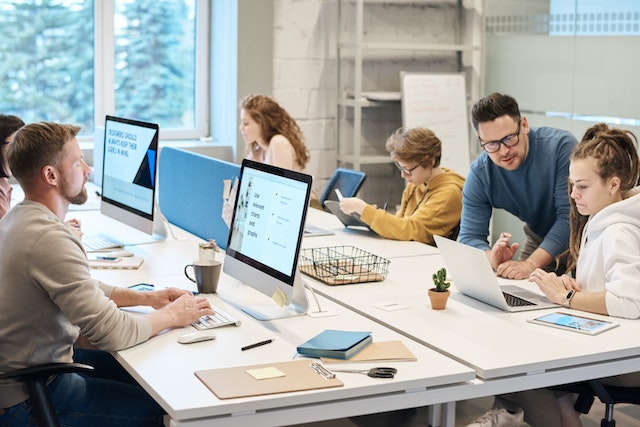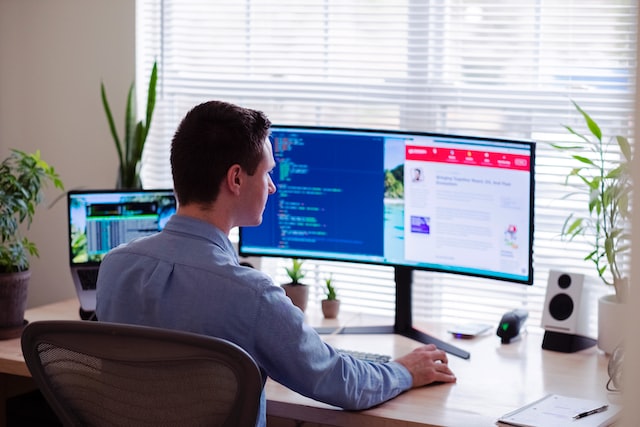The office space market has undergone major changes in the last few years. Shifting business priorities and lingering market uncertainty have necessitated changes in the working landscape – particularly when it comes to the role and function of workplaces. As businesses across the globe face the tentative establishment of a ‘new normal’, it has become abundantly clear that offices, and other places of work, remain in a state of flux.
However, there are some solidifying corporate practices and employee preferences that have been identified as vital to the development of workspace in the years to come. So, as 2022 comes to a close, and we look ahead to the future, it is important to consider the trends that will shape the workplace in the coming years. In this article, we will explore 10 of the most significant trends that are likely to have a significant impact on the office of the future.

The Rise of AI and Machine Learning
The rise of artificial intelligence (AI) and machine learning (ML) is transforming the modern workplace in many ways. As these technologies continue to advance and become more accessible, more and more companies are using AI and ML to automate and streamline their operations, improve decision-making, and enhance the customer experience.
In the office, AI and ML are being used to optimise building management and maintenance, improve energy efficiency, and provide personalised support and services to employees. For example, AI-powered smart building systems can monitor and control lighting, heating, and ventilation, while ML algorithms can be used to predict and prevent potential maintenance issues. In addition, AI and ML can be used to create personalised and adaptive work environments to support and enhance employee performance and well-being.
More Open and Collaborative Workspaces
Highly collaborative work environments are often characterised by their open, flexible layouts, which typically include a mix of individual workstations, shared spaces, and meeting areas. The goal of this type of design is to encourage interaction, creativity, and teamwork among employees. Many companies have come to believe that adopting open, user-centred office designs and collaborative workspaces can improve productivity, foster a sense of community, and support a more flexible and agile work style.
As organisations shift towards more decentralised and flexible structures, the traditional hierarchy and strict division of labour are giving way to more collaborative and participatory models of work, such as self-directed work teams. Office spaces designed to accommodate this shift include features like open-plan layouts, modular furniture, and a variety of different work areas that can be easily reconfigured to support different employee working styles.
While there are some criticisms of these types of environments, such as concerns about noise levels and general lack of privacy, many employers have embraced the trend towards next generation workplace design.

Increasing Emphasis on Corporate Social Responsibility (CSR) and Sustainability
As part of this trend, many companies are looking for ways to make their office spaces more sustainable and environmentally friendly. This can include using eco-friendly materials and design elements – in office construction and renovation – implementing recycling and waste reduction programs, and incorporating sustainable practices into their day-to-day operations.
Furthermore, the integration of technology and automation into the office, such as with smart lighting and temperature control systems, is making these spaces more comfortable and efficient for workers, as well as reducing their carbon footprint. By taking steps to make their office spaces more sustainable, companies are not only helping protect the environment, but also attracting and retaining socially-conscious employees and customers.
Some companies are also partnering with organisations and initiatives that support environmental causes and social justice. The overarching concept of CSR is heavily influencing the amenities, features, causes, and diversity initiatives promoted within the workplace. In addition to the sustainability practices previously mentioned, businesses of the future are set to place even more emphasis on supporting the well-being and productivity of their employees – as well as the wider community – through their actions.
Increasing Employee Engagement Through Gamification
Gamification involves incorporating elements of game-playing into work tasks and activities in order to make them more enjoyable and engaging. This can include using rewards, challenges, competitions, and other game-like elements (including actual video games) to motivate and encourage employees.
In addition to gamification, a growing number of companies are utilising more traditional interactive techniques, such as team-building exercises and collaborative projects, to foster a more engaging and dynamic work environment. These types of techniques, as well as gamification, are especially effective in open office designs and collaborative workspaces, where employees are encouraged to work together and interact in creative and innovative ways.
Expect to see these engaging methods of interaction evolve rapidly in 2023 and beyond, as technological advancement allows for a more seamless connection between the work being done and the rewards being provided through gamification.

Growing Importance of Cybersecurity and Data Privacy
In today’s digital age, cybersecurity and data privacy are becoming increasingly important in the workplace. As businesses increasingly rely on digital technologies to store and access sensitive information, it is crucial that they take steps to protect that information from cyber threats and data breaches. This includes implementing robust cybersecurity measures, such as firewalls, two-factor authentication, and access controls, all whilst training both in-house and remote workers on how to identify and prevent potential security threats.
In addition to protecting against external threats, many companies are also taking steps to ensure that their office spaces are designed and equipped to safeguard against physical data breaches and unauthorised access. This includes using secure locks in concert with biometric access controls, as well as designing office buildings and systems with data protection in mind.
Workplace Mental Health and Wellness Initiatives
As companies increasingly recognise the benefits of a healthy and engaged workforce, expect to see more and more workplaces take steps to support and promote healthy living among their occupants. This can include providing access to fitness facilities and classes, offering healthy food options in the office, introducing mental health initiatives, and helping employees experiencing burnout.
Office spaces themselves are also being built or renovated with health and wellness in mind. Access to natural light and fresh air, ergonomic furniture to help reduce muscle stress, and features like standing desks or exercise equipment, are now all considered essential in the workplace. Additionally, many organisations are also incorporating features such as quiet spaces and meditation rooms into their office spaces to support the mental wellbeing of their employees. Those that are leading the charge have also been known to pay for employee gym memberships, fitness classes, and counselling for those experiencing mental health issues.
By promoting workplace wellness and healthy living, companies are realising the benefits of a more positive and supportive work environment. These benefits include improved employee morale and productivity, reduced risk of chronic health conditions, and an increased ability to regulate work-life balance. Expect to see this trend only continue to grow in 2023, as mental and physical health continues to be a top priority for many employees of all backgrounds.

Introduction of Virtual and Augmented Reality
The increasing prevalence of virtual and augmented reality (VR and AR) in the workplace is set to continue transforming the way many companies operate and interact with their employees, customers, and partners. VR and AR technologies allow users to experience and interact with digital content in a more immersive and realistic way, using specialised hardware and software.
In office space, VR and AR are starting to be used to support a variety of business functions, such as training, product development, and customer service. For example, VR can be used to provide employees with immersive training experiences, allowing them to practice and learn new skills in a safe and controlled environment. AR can be used to enhance product design and visualisation, allowing teams to collaborate and explore ideas in real-time.
VR and AR tools are also poised to make workplaces increasingly mobile. Some pieces of technology, including the Meta Quest Pro, already allow for workers to view an entire virtual desktop through the lenses of a wireless headset – essentially allowing them to take multiple screens wherever they go.
Growth of Coworking Spaces and Shared Office Facilities
The growth of coworking spaces and shared office facilities has been a major trend in recent years, and this is only looking to continue in 2023. These types of spaces provide a flexible and affordable alternative to traditional office spaces, allowing individuals and small businesses to rent workspace on a short-term basis. This flexibility is attractive to many people, including freelancers, entrepreneurs, and remote employees, who value the ability to work in a professional setting without the long-term commitments or high costs of a traditional office lease.
In addition, coworking spaces and shared office facilities often offer a greater range of amenities and services than are found in ‘traditional’ offices, such as large social areas, fully kitted-out meeting rooms, stocked kitchens, and networking events for members. As a result, the demand for these types of spaces has been growing rapidly, making them increasingly common in cities across the globe.
Expect to see this demand skyrocket in the coming years, as businesses begin to reach the end of long-term office lease agreements and employees continue to push for flexible working hours. With the business world becoming increasingly online, it is anticipated these businesses will look to reduce overheads and focus on smaller, more agile workspaces to suit their evolving requirements.

The Rise of Remote Work and the Growing Use of Mobile Technology
With more people working remotely or using mobile devices to access work-related information and tools, the traditional office space is no longer the only place where work gets done. This shift has led to a need for improved home offices and an increased number of flexible spaces that can accommodate a wide range of work styles and activities.
As the number of remote workers increases, there is expected to be a greater emphasis on designing dedicated home offices in new residential builds. These separate workspaces, located away from central living areas, will provide a quiet and distraction-free environment for people to work from. This trend is likely to be particularly appealing to those who prioritise a quiet space for their work.
The future of work is also expected to cater for those who would prefer not to work from a home office, with flexible offices – designed for the increasingly mobile global workforce – expected to be highly prevalent. Already existing in major business hubs, these spaces will include features like seamless wireless connectivity, adaptable furniture, facilities for virtual meetings, and collaboration areas that can be easily reconfigured for different tasks. By designing office spaces that support the needs of a mobile workforce, organisations are creating environments that are functional and empowering of their employees’ work styles and needs. These types of spaces are currently experiencing high-demand from knowledge workers, who typically have jobs that are conducive to hybrid and remote work.
Adoption of Customisable Benefits Packages to Attract and Retain Talent
The adoption of flexible and customisable benefits packages has become a popular way for organisations to attract and retain talent. These types of benefits allow employees to choose the perks and amenities that are most valuable to them, which can help to create a sense of ownership and control over their work experience. In the context of office space, this has meant offering employees the ability to decide between different workspace options, such as a traditional office, a shared workspace, or the option to work remotely.
By providing employees with flexible workplaces, organisations are creating office environments that are more tailored to the individual needs and preferences of their employees. This has been shown to help improve morale, productivity, and retention – increasingly important in the growing war for talent – as well as create a more dynamic and engaging work environment. This is a pressing concern for a lot of businesses, especially as younger generations begin to enter the workplace and expectations around employee experience continue to rapidly evolve.
In terms of benefits, expect to see the future office filled by individuals interacting with amenities or perks that cannot be found at home. For example, a business might look to offer a personalised in-house skills development program to employees as a perk to encourage them to come into the office. Catering the workplace to the unique needs of each employee is something that a lot of top businesses are going to have to do in order to remain competitive in the future talent market.

Looking to Find Your Next Office Space?
Need office space in Central and Greater London? You can explore our wide range of serviced offices and coworking spaces or, alternatively, you can call us on 020 3965 9617 to have a discussion with one of our friendly team members. Our office space experts will be able to connect you and your business to the ideal workspace to suit your unique requirements.
You can also find a number of articles about office space and the future of work below, including:
How to Craft an Office Relocation Announcement (w/ Samples)
Types of Commercial Leases in the UK: What You Need to Know
13 Desk Decor Ideas for Eye-Catching Office Spaces
Digital Transformation Across Industries: From Banking to Retail
The 10 Workplace Trends Defining 2022 So Far
Iconic and Influential Office Spaces in London
